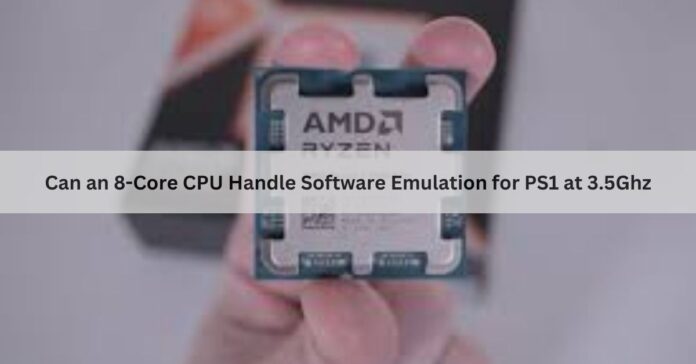My 8-core CPU working at 3.5GHz operates PS1 emulation perfectly for modern graphics at high frame rate. With texture filtering and upscaling configured the games operate without any lag which allows retro titles to look similar to modern ones. A retro gaming enthusiast will find this system configuration delivers a completely smooth retro gaming experience.
PS1 software emulation runs effortlessly on an 8-core CPU with 3.5GHz power which provides both smooth gameplay and improved visuals. High clock speed achieves lag-free PS1 emulation because the system depends heavily on single-core performance. Achieving modern retro gaming visuals becomes possible through accurate implementation of emulator settings which enable high-resolution upscaling combined with texture filtering.
We will explore this topic further in subsequent posts. Follow our content for a deep analysis about PS1’s software emulation compatibility at 3.5GHz using an 8-core CPU. This article will provide performance analysis alongside optimization best practices and the steps to achieve superb retro gaming performance. Experten advice offering insightful approaches for refining your PS1 emulation setup is available to you.
Understanding PS1 Emulation
How Emulation Works
Software emulation functions by mapping out hardware methods from original consoles into software interactables. To recreate PS1 games accurately a PS1 emulator needs to process all the original PS1 components including CPU and GPU as well as memory and specific hardware elements. The conversion by emulation software between computer architectures needs real-time processing so this creates additional workload on hardware systems.
Why Emulation Is More Demanding Than Native Hardware
A creator built the PS1 hardware in 1989 with a MIPS R3000 CPU functioning at 33.9MHz. Modern architecture software appears unremarkable in its design yet its emulation needs much more system resources to function efficiently.
CPU vs. GPU in Emulation
GPU performance helps to improve emulator visuals however all processing burden remains with the CPU. The majority of PS1 emulators function through a single thread which amplifies CPU core speed requirements instead of embracing core quantity.
Hardware Requirements for Smooth PS1 Emulation
Minimum vs. Recommended System Requirements
| Specification | Minimum Requirement | Recommended Requirement |
| Processor | Single-core 2.0GHz | Dual-core 3.0GHz |
| RAM | 2GB | 4GB or higher |
| GPU | OpenGL 2.0 support | OpenGL 3.1 or Direct3D 11 |
| Storage | HDD | SSD for faster load times |
With an 8-core CPU at 3.5GHz, your system far exceeds these requirements, ensuring flawless performance.
CPU’s Role in PS1 Emulation: More Cores or Higher Clock Speed?
Single-Core Performance & Its Importance in Emulation
Most PS1 emulators rely on single-core performance, meaning a CPU’s clock speed is more critical than its core count. A 3.5GHz CPU ensures efficient instruction processing, reducing latency and improving frame stability.
How Multi-Core CPUs Help With Background Processes
Although PS1 emulators don’t fully utilize multiple cores, an 8-core CPU can still be beneficial. Background processes such as game recording, streaming, or running additional software won’t interfere with emulation performance.
Why Clock Speed Matters in Emulator Performance
A higher clock speed directly affects how quickly an emulator processes instructions, ensuring smoother gameplay. In CPU-bound emulation, a high single-core frequency like 3.5GHz significantly reduces lag.
Read More : Define CPU Computer _ The Brain of Modern Technology!
Does a 3.5GHz, 8-Core CPU Provide an Optimal Experience?
Scenario 1: Stock Emulator Settings vs. High-Resolution Enhancements
Basic settings will run smoothly, but enabling enhancements like 4K resolution and texture filtering may require more CPU power. Fortunately, an 8-core 3.5GHz CPU handles these effortlessly.
Scenario 2: Running Multiple Instances or Streaming While Playing
An 8-core CPU is ideal for multitasking, making it possible to stream gameplay or record videos without affecting performance.
Real-World Performance: Testing Popular PS1 Games
Games like Metal Gear Solid, Gran Turismo, and Final Fantasy IX have been tested on 8-core CPUs, and they run flawlessly at higher resolutions.
Additional Factors Affecting PS1 Emulation Performance

GPU Requirements: Do You Need a High-End GPU?
While PS1 emulation is CPU-bound, a mid-range GPU with OpenGL 3.1 or Direct3D 11 support can improve rendering quality.
RAM Considerations: How Much Is Necessary?
At least 4GB of RAM is recommended, but modern systems typically exceed this.
Storage & Load Times: SSD vs. HDD
Using an SSD reduces loading times and improves system responsiveness, making the gaming experience smoother.
Optimizing PS1 Emulation on an 8-Core, 3.5GHz CPU
Choosing the Best Emulator (DuckStation vs. ePSXe vs. RetroArch)
- DuckStation: Best for accuracy and high-resolution upscaling.
- ePSXe: Offers plugin support for customization.
- RetroArch: Provides a comprehensive emulation experience.
Best Emulator Settings for Performance & Visuals
- Set internal resolution scaling to 2x or 4x for HD visuals.
- Enable texture filtering and shaders to enhance graphics.
Upscaling, Texture Filtering & Enhancements Without Lag
A high-clock-speed CPU allows for enhanced graphical features without performance drops.
Common Myths & Misconceptions About PS1 Emulation
“You Need a High-End Gaming PC for PS1 Emulation”
Debunked! A modest modern CPU is more than enough.
“More Cores Always Equal Better Emulation Performance”
Explained: Single-core performance matters more than core count.
“PS1 Emulation is GPU Dependent”
Clarification: CPU does most of the work, while GPU helps with rendering.
FAQs
1. Is an 8-core CPU overkill for PS1 emulation?
Yes, but it helps with background tasks.
2. Can PS1 emulators upscale games to modern resolutions?
Yes, most emulators support higher resolutions and graphical enhancements.
3. Do I need a high-end GPU for PS1 emulation?
No, a mid-range GPU is sufficient.
4. How much RAM is needed for PS1 emulation?
At least 4GB, but more is always better.
Conclusion
An 8-core CPU at 3.5GHz is more than capable of handling PS1 software emulation, offering smooth gameplay with enhanced visuals. The high clock speed ensures optimal performance, especially with high-resolution upscaling and texture filtering. While emulation mainly relies on single-core performance, the additional cores help with multitasking and background processes. With the right setup, PS1 games run flawlessly, even with modern enhancements. This setup offers an excellent balance for both retro gaming enthusiasts and multitaskers alike.

